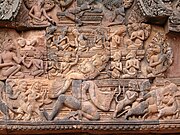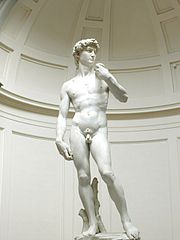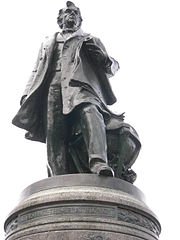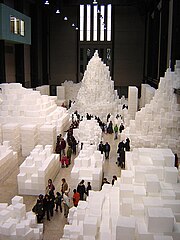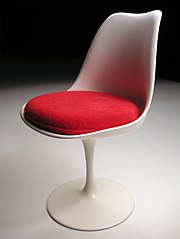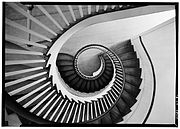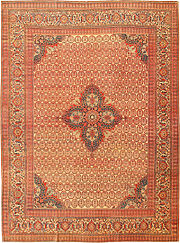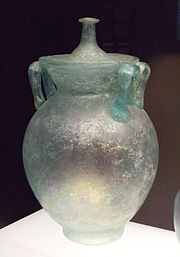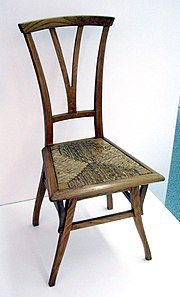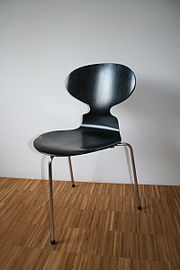Art Appreciation and Techniques/Module 5c Three dimensional media
The following is an initial page plan for the module. The beginning text, before the colon, is the proposed page name.
- Overview: introduction
- Introduction: definitions and processes
- Sculpture and other three-dimensional media: Sculpture & Types of sculpture and other three-dimensional media
- Methods: Methods
- Modern variations: Modern variations of three-dimensional media
- Summary: conclusion
Contents
Three-Dimensional Media
Introduction
In this module we look at three-dimensional works of art, the methods artists use to create them and the different categories they occupy. Here is the outline for this module’s content:
- Definition
- Processes:
a. Additive
b. Subtractive
- Types of Sculpture and other Three-Dimensional Media:
1. Freestanding
2. Relief:
a. Bas relief
b. High relief
- Methods:
a. Carving
b. Casting
c. Modeling
d. Construction/Assemblage
- Modern Variations of Three-Dimensional Media:
a. Installation Art
b. Performance Art
Definition
Three-dimensional media occupies space defined through the dimensions of height, width and depth. It includes sculpture, installation and performance art, decorative art, and product design.
Processes
Two processes are responsible for all three-dimensional art: additive, in which material is built up to create form, or subtractive, where material is removed from an existing mass, such as a chunk of stone, wood or clay. The different categories we’ll examine here are not necessarily exclusive from each other, and we will look at some examples of three-dimensional art that arguably cross over between categories. First, let’s look at the different types of sculpture and the methods used to creating them to understand the important characteristics of each one.
Sculpture
Sculpture is any artwork made by the manipulation of materials resulting in a three-dimensional object. The sculpted figure of the Venus of Berekhat Ram, discovered in the Middle East in 1981, dates to 230,000 years BCE. It is the oldest example of artwork known. The crudely carved stone figure will fit in the palm of your hand. Its name derives from the similarity in form with so-called female fertility figures found throughout Europe, some of which date to 25,000 years ago. For example, The form of the Venus of Willendorf below shows remarkable skill in its carving, including arms draped over exaggerated breasts, an extended abdomen and elaborate patterning on the head, indicating either a braided hairstyle or type of woven cap. Just as remarkable, the figure has no facial detail to indicate identity. The meaning behind these figures is difficult to put into context because of the lack of any written record about them or other supporting materials.
These earliest images are indicative of most of the cultural record in sculpture for thousands of years; singular figurative objects made within an iconographic context of myth, ritual or ceremony. It’s not until the Old Kingdom period of Egyptian sculpture, between 3100 and 2180 BCE, that we start to see sculpture that reflects a resemblance of specific figures.
Types of Sculpture and Three-dimensional Media
Sculpture can be freestanding, or self-supported, where the viewer can walk completely around the work to see it from all sides, or created in relief, where the primary form’s surface is raised above the surrounding material, such as the image on a coin. Bas-relief refers to a shallow extension of the image from its surroundings, high relief is where the most prominent elements of the composition are undercut and rendered at more than half in the round against the background. Rich, animated bas-relief sculpture exists at the Banteay Srei temple near Angor Wat, Cambodia. Here humans and mythic figures combine in depictions from ancient Hindu stories.
The Shaw Memorial combines freestanding, bas and high relief elements in one masterful sculpture. The work memorializes Colonel Robert Gould Shaw and the Massachusetts Fifty fourth regiment, the first African-American infantry unit to fight for the north in the civil war.
Methods
1.Carving uses the subtractive process to cut away areas from a larger mass, and is the oldest method used for three-dimensional work. Traditionally stone and wood were the most common materials because they were readily available and extremely durable. Contemporary materials include foam, plastics and glass. Using chisels and other sharp tools, artists carve away material until the ultimate form of the work is achieved.
A beautiful example of the carving process is seen in the Water and Moon Bodhisattva from 10th century China. The Bodhisattva, a Buddhist figure who has attained Enlightenment but decides to stay on earth to teach others, is exquisitely carved and painted. The figure is almost eight feet high, seated in an elegant pose on a lotus bloom, relaxed, staring straight ahead with a calm, benevolent look. The extended right arm and raised knee create a stable triangular composition. The sculptor carves the left arm to simulate muscle tension inherent when it supports the weight of the body.
In another example, you can see the high degree of relief carved from an original wood block in this mask from the Pacific Northwest Coast Kwakwaka’ wakw culture. The mask was used in winter ceremonies where animals were said to take human form. It’s extraordinary for masks to personify a natural event. This and other mythic figure masks are used in ritual and ceremony dances. The broad areas of paint give a heightened sense of character to this mask.
Wood sculptures by contemporary artist Ursula von Rydingsvard are carved, glued and even burned. Many are massive, rough vessel forms that carry the visual evidence of their creation.
Michelangelo’s masterpiece Statue of David from 1501 is carved and sanded to an idealized form that the artist releases from the massive block, a testament to human aesthetic brilliance.
2. Casting: The additive method of casting has been in use for over five thousand years. It’s a manufacturing process by which a liquid material is usually poured into a mold, which contains a hollow cavity of the desired shape, and then allowed to solidify. One traditional method of bronze casting frequently used today is the lost wax process. Casting materials are usually metals but can be various cold setting materials that cure after mixing two or more components together; examples are epoxy, concrete, plaster and clay. Casting is most often used for making complex shapes that would be otherwise difficult or uneconomical to make by other methods. It’s a labor-intensive process that allows for the creation of multiples from an original object (similar to the medium of printmaking), each of which is extremely durable and exactly like its predecessor. A mold is usually destroyed after the desired number of castings has been made. Traditionally, bronze statues were placed atop pedestals to signify the importance of the figure depicted. A statue of William Seward (below), the U. S. Secretary of State under Abraham Lincoln and who negotiated the purchase of the Alaska territories, is set nearly eight feet high so viewers must look up at him. Standing next to the globe, he holds a roll of plans in his left hand.
More contemporary bronze cast sculptures reflect their subjects through different cultural perspectives. The statue of rock guitarist Jimi Hendrix is set on the ground, his figure cast as if performing on stage. He’s on both of his knees, head thrown back, eyes shut and mouth open in mid wail. His bell-bottom pants, frilly shirt unbuttoned halfway, necklace and headband give us a snapshot of 1960’s rock culture but also engage us with the subject at our level.
3. Modeling is a method that can be both additive and subtractive. The artist uses modeling to build up form with clay, plaster or other soft material that can be pushed, pulled, pinched or poured into place. The material then hardens into the finished work. Larger sculptures created with this method make use of an armature, an underlying structure of wire that sets the physical shape of the work. Although modeling is primarily an additive process, artists do remove material in the process. Modeling a form is often a preliminary step in the casting method. In 2010, Swiss artist Alberto Giacometti’s Walking Man (c. 1955), a bronze sculpture first modeled in clay, set a record for the highest price ever paid for a work of art at auction.
4. Construction, or Assemblage, uses found, manufactured or altered objects to build form. Artists weld, glue, bolt and wire individual pieces together. Sculptor Debra Butterfield transforms throw away objects into abstract sculptures of horses with scrap metal, wood and other found objects. She often casts these constructions in bronze.
Louise Nevelson used cut and shaped pieces of wood, gluing and nailing them together to form fantastic, complex compositions. Painted a single tone, (usually black or white), her sculptures are graphic, textural facades of shapes, patterns and shadow.
Traditional African masks often combine different materials. The elaborate Kanaga Mask from Mali uses wood, fibers, animal hide and pigment to construct an other worldly visage that changes from human to animal and back again.
Some modern and contemporary sculptures incorporate movement, light and sound. Kinetic sculptures use ambient air currents or motors allowing them to move, changing in form as the viewer stands in place. The artist Alexander Calder is famous for his mobiles, whimsical, abstract works that are intricately balanced to move at the slightest wisp of air, while the sculptures of Jean Tinguely are contraption-like and, similar to Nevelson’s and Butterfield’s works, constructed of scraps often found in garbage dumps. His motorized works exhibit a mechanical aesthetic as they whir, rock and generate noises. Tinguely’s most famous work, Homage to New York, ran in the sculpture garden at New York’s Museum of Modern Art in 1960 as part of a performance by the artist. After several minutes, the work exploded and caught fire.
The idea of generating sound as part of three-dimensional works has been utilized for hundreds of years, traditionally in musical instruments that carry a spiritual reference. Contemporary artists use sound to heighten the effect of sculpture or to direct recorded narratives. The cast bronze fountain by George Tsutakawa uses water flow to produce a soft rushing sound. In this instance the sculpture also attracts the viewer by the motion of the water: a clear, fluid addition to an otherwise hard abstract surface.
Doug Hollis’ A Sound Garden from 1982 creates sounds from hollow metal tubes atop grid like structures rising above the ground. In weather vane fashion, the tubes swing into the wind and resonate to specific pitch. The sound extends the aesthetic value of the work to include the sense of hearing and, together with the metal construction, creates a mechanical and psychological basis for the work.
Modern Variations of Three-Dimensional Media
Flavin is one of the first artists to explore the possibilities of light as a sculptural medium. Since the 1960’s his work has incorporated fluorescent bulbs of different colors and in various arrangements. Moreover, he takes advantage of the wall space the light is projected onto, literally blurring the line between traditional sculpture and the more complex medium of installation.uorescent bulbs of different colors and in various arrangements. Moreover, he takes advantage of the wall space the light is projected onto, literally blurring the line between traditional sculpture and the more complex medium of installation.
Installation Art
Installation art utilizes multiple objects, often from various mediums, and takes up entire spaces. It can be generic or site specific. Because of their relative complexity, installations can address aesthetic and narrative ideas on a larger scale than traditional sculpture. Its genesis can be traced to the Dada movement, ascendant after World War I and which predicated a new aesthetic by its unconventional nature and ridicule of established tastes and styles. Sculpture came off the pedestal and began to transform entire rooms into works or art. Kurt Schwitters’ Merzbau, begun in 1923, transforms his apartment into an abstract, claustrophobic space that is at once part sculpture and architecture. With installation art the viewer is surrounded by and can become part of the work itself.
British artist Rachel Whiteread’s installation Embankment from 2005 fills an entire exhibition hall with casts made from various sized boxes. At first appearance a snowy mountain landscape navigated by the viewer is actually a gigantic nod to the idea of boxes as receptacles of memory towering above and stacked around them, squeezing them towards the center of the room.
Ilya Kabakov mixes together a narrative of political propaganda, humor and mundane existence in his installation The Man Who Flew Into Space From His Apartment from 1984. What we see is the remains of a small apartment plastered with Soviet era posters, a small bed and the makeshift slingshot a man uses to escape the drudgery of his life within the system. A gaping hole in the roof and his shoes on the floor are evidence enough that he made it into space.
Performance Art
Performance art goes a step further, involving the artist as part of the work itself. Some performance artworks are interactive, involving the viewer too. The nature of the medium is in its ability to use live performance in the same context as static works of art: to enhance our understanding of artistic experience. Similar to installation works, performance art had its first manifestations during the Dada art movement, when live performances included poetry, visual art and music, often going on at the same time.
The German artist Joseph Beuys was instrumental in introducing performance art as a legitimate medium in the post World War Two artistic milieu. I Like America and America Likes Me from 1974 finds Beuys co-existing with a coyote for a week in the Rene Block Gallery in New York City. The artist is protected from the animal by a felt blanket and a shepherd’s staff. Performance art, like installation, challenges the viewer to reexamine the artistic experience from a new level.
In the 1960’s Allen Kaprow’s Happenings invited viewers to be the participants. These events, sometimes rehearsed and other times improvised begin to erase the line between the artist and the audience. Yoko Ono’s Cut Piece from 1965 specifically invites members of the audience to interact with her on stage.
This same idea – using the artist’s body as subject, is evident in the performance art of Marina Abramovic. In The Artist is Present she sits quietly as individual visitors sit across the table from her, exchanging silent glances and stares.
Today we see a new form of performance art happen unexpectedly around us in the form of Flash Mobs: groups of people who gather in public spaces to collaborate in short, seemingly spontaneous events that entertain and surprise passersby. Many flash mobs are arranged in advance through the use of social media. An example of flash mob performance is Do Re Mi in the Central Station in Antwerp, Belgium in March of 2009.
Decorative Arts
Decorative art requires the specific skilled use of tools in creating works or art. These tools can take many forms: words, construction tools, a camera, a paintbrush or even a voice. Traditional studio arts include ceramics, metal and woodworking, weaving and the glass arts. Decorative arts are distinguished by a high degree of workmanship and finish. They have their roots in utilitarian purposes: furniture, utensils and other everyday accoutrements that are designed for specific uses, and reflect the adage that “form follows function”. But human creativity goes beyond simple function to include the aesthetic realm, entered through the doors of embellishment, decoration and an intuitive sense of design.
In the first example below, the smooth simple lines of a Tulip Chair, were designed by Eero Saarinen as an exercise in clarifying form. When it was made its futuristic use of curved lines and artificial materials were seen as emblematic of the “space age.” In another example, a staircase crafted in the Shaker style takes on an elegant form that mirrors the organic spiral shape representing the ‘golden ratio’ we explored in module 4.
Utility is not the sole purpose of decorative arts. The Persian carpet below has its use as a utilitarian object, but the craftsmanship shown in its pattern and design gives it a separate aesthetic value. The decorative element is visually stimulating, as if the artisan uses the carpet as simply a vehicle for his or her own creative imagination.
As we’ve seen in an earlier module, quilts made in the rural community of Gee's Bend Alabama show a diverse range of individual patterns within a larger design structure of colorful stripes and blocks, and have a basis in graphic textile designs from Africa.
Even a small tobacco bag from the Native American Sioux culture (below) becomes a work of art with its intricate beaded patterns and floral designs.
The craftsmanship in glass making is one of the most demanding. Working with an extremely fragile medium presents unique challenges. Challenges aside, the delicate nature of glass gives it exceptional visual presence. A blown glass urn dated to first century Rome is an example. The fact that it has survived the ages intact is testament to its ultimate strength and beauty.
Louis Comfort Tiffany introduced many styles of decorative glass between the late 19th and first part of the 20th centuries. His stained glass window The Holy City in Baltimore Maryland has intricate details in illustrations influenced by the Art Nouveau style popular at the turn of the 19th century.
The artist Dale Chihuly has redefined the traditional craft of glass making over the last forty years, moving it towards the mainstream of fine art with single objects and large scale installations involving hundreds of individual pieces.
Product Design
The dictum “form follows function” represents an organic approach to three-dimensional design. The products and devices we use everyday continue to serve the same functions but change in styles. This constant realignment in basic form reflects modern aesthetic considerations and, on a larger scale, become artifacts of the popular culture of a given time period.
The two examples below illustrate this idea. Like Tiffany glass, the chair designed by Henry van de Velde in 1895 reflects the Art Nouveau style in its wood construction with organic, stylized lines and curvilinear form. In comparison, the Ant Chair from 1952 retains the basic functional form with more modern design using a triangular leg configuration of tubular steel and a single piece of laminated wood veneer, the cut out shape suggesting the form of a black ant.
Conclusion
Three-dimensional media includes many forms including sculpture, decorative arts, and product design. They are the oldest and most durable of all the creative arts. You can see how the different creative processes and methods generate a diverse range of visual forms and characteristics. Decorative art in particular has its origins in utility but is no longer exclusive to this realm, and innovations about the nature of three-dimensional media have led to the contemporary forms of installation and performance art, with the inclusion at times of both the artist and the viewer into the work itself. You’ll experience and learn more about three-dimensional media in the learning activities that accompany this module.

